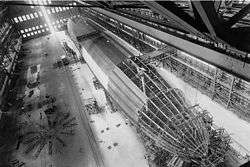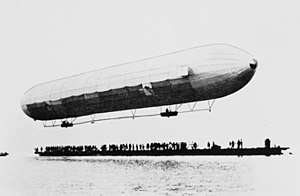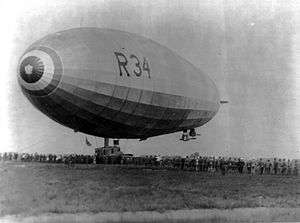Rigid airship
A rigid airship is a type of airship (or dirigible) in which the envelope is supported by an internal framework rather than by being kept in shape by the pressure of the lifting gas within the envelope, as in blimps (also called pressure airships) and semi-rigid airships.[1][2] Rigid airships are often commonly called Zeppelins, though this technically refers only to airships built by the Luftschiffbau Zeppelin company.

Rigid airships were produced and relatively successfully employed from the beginning of the 1900s to the end of the 1930s; their heyday ended when the Hindenburg caught fire on May 6, 1937.
Construction and operation
Rigid airships consist of a structural framework usually covered in doped fabric containing a number of gasbags or cells containing a lifting gas. In the majority of airships constructed before World War II highly flammable hydrogen was used for this purpose, resulting in many airships such as the British R101 and the German Hindenburg being lost in catastrophic fires. The inert gas helium was used by American airships in the 1920s and '30s and is used in all modern airships.
Although airships rely on the difference in density between the lifting gas and the surrounding air to stay aloft they can also generate a certain amount of aerodynamic lift by using their elevators to fly in a nose-up attitude. Similarly, by flying nose-down down-force can be generated: this may be done to prevent the airship rising above its pressure height. Typically airships start a flight with their gasbags inflated to about 95% capacity: as the airship gains height the lifting gas expands as the surrounding atmospheric pressure reduces. The height at which the internal pressure of the gasbags equals external atmospheric pressure is called the pressure height: if the airship climbs beyond this it is necessary to vent gas in order to prevent the gasbags' rupturing.
History
Early history
By 1874 several people had conceived of a rigid dirigible (in contrast to non-rigid powered airships which had been flying since 1852). The Frenchman Joseph Spiess had patented a rigid airship design in 1873 but failed to get funding.[3] Count Zeppelin had outlined his thoughts of a rigid airship in diary entries from 25 March 1874 through to 1890 when he resigned from the military.[4] David Schwarz had thought about building an airship in the 1880s and had probably started design work in 1891: by 1892 he had started construction.[5] It was not until after Schwarz's death in 1897 that his all-aluminium airship, built with help from the industrialist Carl Berg and the Prussian Airship Battalion, was test flown. Schwarz and Berg had an exclusive contract and Count Zeppelin was obliged to come to a legal agreement with Schwarz's heirs to obtain aluminium from Carl Berg, although the two men's designs were different and independent from each other: the Schwarz design lacked the separate internal gasbags that characterise rigid airships.[6] With Berg's aluminium, Zeppelin was able to start building his first airship in 1899.
First practical rigid airships

Ferdinand von Zeppelin completed his first airship, the LZ 1 in July 1900. Constructed in a floating shed on Lake Constance, it was 128.02 m (420 ft) long, 11.73 m (38 ft 6 in) in diameter with a volume of 11,298 m3 (399,000 ft 3) and was powered by two 11 kW (14 hp) Daimler engines. The first flight, lasting 20 minutes, was made on 2 July, but ended with the airship being damaged. After repairs and modifications two further flights were made in October 1900.[7] These experiments failed to attract any investors, and Count Zeppelin did not complete his next design, LZ 2, until 1906. This made only a single flight on 17 January 1906. After both engines failed it made a forced landing in the Allgäu mountains, where a storm subsequently damaged it beyond repair. A similar design, the LZ 3 was soon completed. This performed well enough to interest the German Army, but they required an airship capable of flying for 24 hours. This was beyond the capability of LZ 3, so a larger craft, LZ 4, was built. This was 136 m (446 ft) long, 12.95 m (42 ft 6 in) in diameter and powered by two Daimler engines delivering a total of 156 kW (210 hp).[8] LZ 4 first flew on 20 June 1908, and on 1 July made a spectacular 12 hour cross-country flight during which it was flown over Switzerland to Zürich and then back to Lake Constance. The 24-hour trial was started on 4 August, but was interrupted by the failure of one of the engines. It was moored near Echterdingen in order to make repairs but a storm arose and it broke away from its moorings, was blown into some trees and caught fire. The disaster took place in front of an estimated 40 to 50 thousand spectators [9] and produced an extraordinary wave of nationalistic support for Zeppelin's work. Unsolicited donations from the public poured in: enough had been received within 24 hours to rebuild the airship, and the eventual total was over 6 million marks were donated, finally giving Count Zeppelin a sound financial base for his experiments.[10]
Seven were operated by DELAG, the first airline in the world. In the five years prior to the outbreak of war their Zeppelin airships carried 32,722 passengers on over 1,588 flights totalling 172,530 kilometres (107,210 mi). Commercial services ended in Germany at the outbreak of World War I, when the airships were taken over by the military.
In 1911 the first rigid airship produced by the German Schütte-Lanz company was flown. Designed by the naval architect Johann Schütte, the Schütte-Lanz introduced a number of technical innovations. The shape of the hull was more streamlined than the early Zeppelin craft, the hulls of which were cylindrical for most of their length, simplifying construction at the expense of aerodynamic efficiency. Other Schütte-Lanz innovations included the use of an axial cable running the length of the airship to reduce additional stressing caused by the partial deflation of a single gasbag, the introduction of venting tubes to carry any hydrogen vented to the top of the ship and simplified cruciform tail surfaces.

The British Royal Navy took an early interest in rigid airships and ordered His Majesty's Airship No. 1 in 1909 from Vickers Limited at Barrow-in-Furness. It was 512 ft (156.06 m) long with two Wolseley engines. It was completed in 1911 but broke in two before its first flight and was scrapped.[11] This caused a temporary halt to British airship development, but in 1913 an order was placed for HMA No. 9r. This was not completed until April 1917.
France's only rigid airship was designed by Alsatian engineer Joseph Spiess and constructed by Société Zodiac at the Aérodrome de Saint-Cyr-l'École.[12] It had a framework of hollow wooden spars braced with wire, and was given the name Zodiac XII but had the name SPIESS painted along the side of the envelope.[13] It was 113 m (370 ft 9 in) long, with a diameter of 13.5 m (44 ft 3 in) and was powered by a single Chenu 200 hp engine that drove two propellers. It first flew on 13 April 1913, but it became clear that it was underpowered and required more lift, so it was lengthened to 140 m 459 ft 4 in) to accommodate three more gas cells and a second engine was added. Spiess then presented the airship to the French government as a gift.[14] After further trials it was not accepted by the French military, because their view was that smaller non-rigid types would be more effective.[15] The Spiess airship seems to have been broken-up in 1914.
World War I
During World War I the Zeppelin company built 95 military airships. These were operated by both the Navy and the Army. German military airship stations had been established before the War and on September 2–3, 1914, the Zeppelin LZ 17 dropped three 200 lb bombs on Antwerp in Belgium. In 1915 a bombing campaign against England using airships was initiated, the first raid taking place on 19 January 1915 when two airships dropped bombs on Norfolk. On 31 May 1915 the first bombs fell on London. Raids continued throughout 1915 and continued into 1916. On the night of September 2–3, 1916 the first German airship was shot down over English soil by Lt. Leefe Robinson flying a BE 2c. This and subsequent successes by England’s defences led to the development of new Zeppelin designs capable of operating at greater altitudes, but even when these came into service the Germans only carried out a small number of airship raids on Britain during the rest of the war, carrying on the campaign using aeroplanes and reserving their airships for their primary duty of naval patrols over the North Sea and the Baltic. The last casualties occurred on 12 April 1918.[16]
The first British airship to be completed during the war was No. 9r, which was first flown at the end of 1916 and was used for experimental and training purposes. By then, the war against U-Boats was at its height and 9r was quickly followed by 4 airships of the 23 Class, two R23X Class and two R31 Class,[17] the last being based on the Schütte-Lanz principle of wooden construction, and remain the largest mobile wooden structures ever built.[18] The only significant combat success of these airships, aside from their deterrent effect, was assistance in the destruction of SM UB-115 by R29 in September 1918.[19]
1919–1939

At the end of the war two British airships of the R33 Class were nearing completion. R33 became a civilian airship, finishing her career doing experimental work. The R34 became the first aircraft to complete a return Atlantic crossing in July 1919 but was severely damaged in January 1921 and was subsequently scrapped.[20] R36 was the only airship of the R35 class to be completed; it entered civilian service but was damaged three months after its first flight and was never repaired.[21] Four airships of the R38 Class were started but only one completed: it was sold to the US Navy and renamed ZR-2. In June 1921 it broke up in the air over Kingston-upon-Hull before it could be delivered, killing 44 of its Anglo-American crew. The last airship that had been ordered in World War I was the R80; it was completed in 1920 but was tested to destruction in the following year after it was found to have no commercial use.[22]
After the end of World War I Zeppelin resumed building and operating civilian airships. Under the terms of the Treaty of Versailles they were prohibited from building airships of over a million cubic ft capacity, but two small passenger airships, LZ 120 Bodensee and a sister ship LZ 121 Nordstern were built, intended for use between Berlin and Freidrichshafen. They were subsequently confiscated and handed over to Italy and France as war reparations in place of wartime Zeppelins which had been sabotaged by their crews in 1919. The Zeppelin company was saved from extinction by an order for an airship from the US Navy. This, the USS Los Angeles (ZR-3), was delivered to the US Navy in October 1924.
_in_flight_over_Manhattan%2C_circa_1931-1933.jpg)
In 1924 the British Government initiated the Imperial Airship Scheme, a plan to join the British Empire with airship routes. This involved the construction of two large airships, the R100 and R101, paid for by the government. The R100 was privately built by Vickers-Armstrongs using existing commercial practices, with a design team led by Barnes Wallis who had co-designed the R80. After her first flight in December 1929, R100 made a successful round trip to Quebec in Canada in July and August the following year. The competing R101 was designed and built by the Air Ministry and was supposed to encourage new approaches. R101 was severely overweight, largely due to the decision to use diesel engines to reduce fire risk, and it was decided to lengthen the airship's hull to increase lift. In October 1930 R101 set off to Karachi on its first overseas flight but crashed in northern France in bad weather killing 48 of the 54 people on board, including the Secretary of State for Air and most of the design team. Following this disaster, the R100 was grounded and was finally scrapped in November 1931, marking the end of British interest in rigid airships.[23]
In 1926 Zeppelin Lufftschiffbau began construction of LZ 127 Graf Zeppelin. Completed in 1928, this was the most successful passenger airship to be built.
The United States rigid airship program was based at Lakehurst Naval Air station, New Jersey. USS Shenandoah (ZR-1) was the first rigid airship constructed in America, and served from 1923 to 1925, when it broke up in mid-air in severe weather, killing 14 of the crew. USS Los Angeles (ZR-3) was a German airship built for the United States in 1924. The ship was grounded in 1931, due to the Depression, but was not dismantled for over 5 years. The sister ships Akron and Macon both crashed. The Akron was flown into the sea in bad weather and broke up. Over seventy were killed, including one of the US Navy's proponents of airships, Rear Admiral William A. Moffett. Macon also ended up in the sea when it flew into heavy weather with unrepaired damage from an earlier incident, but the introduction of life-jackets following the loss of the Akron meant only two lives were lost.
LZ 129 Hindenburg carried passengers, mail and freight on regularly scheduled commercial services from Germany to North and South America. These were stopped after the Hindenburg disaster in 1937, with only some thirty European test and government-sponsored flights of its completed sister airship, the LZ 130 Graf Zeppelin II, before the LZ 130's breakup in Germany in April 1940.
Demise
Following the Hindenburg disaster, the Zeppelin company resolved to use helium in their future passenger airships. But by this time Europe was well on the path to World War II, and the United States, the only country with substantial helium reserves, refused to sell the necessary gas. Commercial international aviation was limited during the war, so development of new airships was halted. Following the rapid advances in aviation during and after World War II, fixed-wing heavier-than-air aircraft, able to fly much faster than rigid airships, became the favoured method of international air travel.
Modern rigids
The Zeppelin company refers to their NT ship as a rigid, but the envelope shape is retained in part by super-pressure of the lifting gas, and so the NT is more correctly classified as semi-rigid.[1]
Aeroscraft was certified airworthy by the FAA in September 2013 and has begun flight testing.[24]
See also
- List of Zeppelins
- List of Schütte-Lanz rigid airships
- Airship hangar
- Rigid Airship Design
References
- Mueller, Joseph B.; Michael A. Paluszek; Yiyuan Zhao (2004). "Development of an aerodynamic model and control law design for a high altitude airship" (PDF). American Institute of Aeronautics and Astronautics: 2. Cite journal requires
|journal=(help) - Konstantinov, Lev (2003). "The Basics of Gas and Heat Airship Theory". Montgolfier. Kyiv, Ukraine: AEROPLAST Inc. 1: 4–6, 8.
- Dooley A.174 citing Hartcup p89
- Dooley A.175
- Dooley A.183
- Dooley A.184-A.196
- Robinson 1973 pp.23–4
- Robinson 1973 p. 331
- "Count Zeppelin's Airship". The Times. London (38718): 3. 6 August 1908.
- Robinson 1973 p. 41.
- Patrick Abbott and Nick Walmsley, British Airships in Pictures: An Illustrated History, House of Lochar 1998, ISBN 1-899863-48-6 (pp.20–21)
- "Google Translate - EntreVoisins: Birthplace of the first rigid frame airship". google.co.uk.
- "The Project Gutenberg eBook of Jane's All The World's Aircraft 1913, "Zodiac XII" Edited by Fred T. Jane". gutenberg.org. p. 125.
- "D'Orcy's airship manual; an international register of airships with a compendium of the airship's elementary mechanics". archive.org.
- John Pike. "French Airships / Dirigeable - The Great War". globalsecurity.org.
- Bishop, Chris, Editor. 2001. The Encyclopedia of 20th Century Air Warfare. New York, NY: Barnes & Noble Books, by arrangement with Amber Books Ltd, London.
- Abbott & Walmsley, (pp.59–69)
- Naval Historical Society of Australia. "The Mystery of Airship R31 » NHSA". navyhistory.org.au.
- Wrecksite Database: UB-115 [+1918]
- Castle, pp.31–32
- Castle pp.34–35
- Castle pp.35–36
- Castle pp.36–38
- Francis X Govers III. "Aeroscraft begins flight testing following FAA certification". Gizmag. Retrieved 26 September 2013.
- Bibliography
- Dooley, Sean C., The Development of Material-Adapted Structural Form – Part II: Appendices. THÈSE NO 2986 (2004), École Polytechnique Fédérale de Lausanne
- Hartcup, Guy. The Achievement of the Airship: A History of the Development of Rigid, Semi-Rigid and Non-Rigid Airships. David & Charles: London. 1974.
- Price Bradshaw: The role of technology in the failure of the rigid airship as an invention. Dissertation, University of Florida 1975. Online via Archive.org
- Robinson, Douglas H. Giants in the Sky. Henley-on-Thames: Foulis, 1973 ISBN 0854291458
- Ian Castle British Airships 1905–30 Osprey Publishing, 2013
External links
| Wikimedia Commons has media related to Rigid airships. |
- Airships.net: The Hindenburg and other Zeppelins
- "Biggest Birds That Ever Flew" Popular Science, May 1962